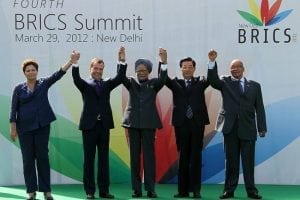Latest News
BRICS Nations Promising for Future Capacity Demand
[Via Satellite 11-25-2014] Representing close to half the world’s population, the BRICS nations — Brazil, Russia, India, China and South Africa — are markets the satellite industry has been watching closely to gauge how their national growth rates correlate to that of the industry. In its “BRICS Satellite Capacity Supply and Demand Report,” NSR estimates that Fixed Satellite Services (FSS) demand in the five BRICS nations will near 600 Transponder Equivalents (TPEs) by 2023, with High Throughput Satellite (HTS) demand rising to almost 100 Gbps.
Emerging markets have become key drivers of new capacity for satellite operators around the world. Earlier this year the Satellite Industry Association (SIA) noted that economic growth in satellite has been stronger than the global average. Blaine Curcio, senior analyst at NSR, told Via Satellite that the BRICS can be effectively split into three groups when comparing satellite industry growth to their overall economies. For India and Russia, the satellite telecom sector has outpaced their overall growth. Brazil and South Africa have seen relatively parallel growth when comparing satellite to the national average, while in China satellite telecom growth has been below the national average.
The demand for satellite capacity throughout BRICS is driven by a combination of public and private customers. Curcio said Brazil and India are seeing the most balanced between public and private sector demand with Direct-to-Home (DTH) broadcasting exploding in recent years. In South Africa, DTH, mining and government demand have fueled the need for capacity that, without a domestic operator, has been supplied entirely by foreign providers. Curcio said Russia’s state-owned enterprises remain the nation’s largest buyers, particularly in oil and gas, and mining. NSR sees demand in China staying relatively stable over the next five years, though growth here is not as strong when compared to satellite in the other BRICS nations.
“The Chinese economy in general has grown at unprecedented rates when looking at the long-term historical growth rates of any country. However, its satellite telecom sector, due to a number of factors (good terrestrial development, lack of foreign operators, closed market, etc.) has not kept pace by a long shot,” Curcio said.
The BRICS nations also provide opportunities for future satellites, including HTS. Earlier this year Hughes do Brasil purchased all of the upcoming Eutelsat 65’s Ka-band HTS capacity in hopes of replicating the company’s success in the United States. Hispasat currently has HTS spot beams over Brazil, and has more satellites planned, as do Intelsat and other operators. The Brazilian government is also seeking to obtain a greater level of national sovereignty through its own HTS spacecraft, the Geostationary Defense and Strategic Communications Satellite (SGDC 1). Under construction by Thales Alenia Space, SGDC 1 will carry 50 Ka-band transponders, for throughput of up to 80 Gbps, and seven X-band transponders. Curcio said other countries could look to imitate Brazil’s approach.
“I would say that this type of program may become more common in developing countries. SGDC 1, for instance, likely cost somewhere in the neighborhood of $500 million, all in. The economic benefits of connecting a couple million residents of medium-sized cities throughout rural Brazil must, over the 15ish year life span of a satellite, vastly outweigh the startup costs for such a program,” he said.
The BRICS nations vary in their ability to domestically manufacture satellites, with Russia by far having the most experience. Curcio notes that South Africa has become adept at building remote sensing spacecraft, but not so much for telecommunications. As such, Intelsat and companies such as Spacecom , SES and Eutelsat have been top providers. The Indian Space Research Organization (ISRO) has a dominant position in India due to regulatory policies, but has allowed foreign operators to supply capacity.
In terms of how BRICS compare regarding regulatory friendliness, Curcio said “If I were to rank the countries, from ‘most favorable’ to ‘least favorable,’ it would probably be Brazil, South Africa, India, Russia, China — with China in last place by a fairly wide margin. Brazil and South Africa have both been receptive to foreign operators … [India] does have some regulatory issues, but overall I think that the government has been pretty pragmatic in realizing that they need some help on the supply side from foreign operators, so they’ve made it a bit easier. Russia, as noted, has ample domestic supply and therefore has made it more difficult for foreign operators to compete, with Eutelsat being a notable exception.”
Get the latest Via Satellite news!
Subscribe Now